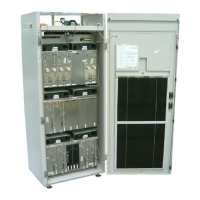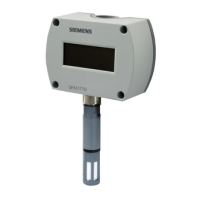18
A30808-X3247-L14-2-7618
Technical Description (TED:BSS)
BS-240/241
Information
Base Station System
switch over, the SELICs on the active CORE are disabled by the switch logic and the
SELICs on the passive one are enabled. The SELICs on the CORE have to know
whether they are on the active or on the passive CORE. For this reason the SELICs
need a active/passive pin, which is served by the redundancy switch logic. When a
switch over occurs, the switch logic sets the active/passive pin of the former active
SELICs to "passive" and that of the former passive SELICs to "active".
The SELICs on the CUs have to recognize automatically which link comes from the
active CORE and which link from the passive one, i.e. it has to recognise a CORE switch
over by itself.
The RD interface (redundancy interface) is realized as a 2 Mbit/s HDLC link which
provides a communication interface between the two main processors (mP).
The switch logic is a flip-flop distributed over the two COREs. It manages the HW part
of a switch over and enables the COREs to know about their states as active/passive.
The CLK of the active CORE is connected with the one on the passive CORE. It allows
the passive CLK to be synchronized to the active one.
NOTE: the redundancy is implemented in a cold-standby mode, i.e., all calls will get lost
if a CORE switch over occurs.
2.2 Power Amplifier Output Level (typical values)
Modulation Output Power
(dBm)
Output Power
(Watt)
GSM 900 CUGV3 GMSK 47.3 53.7
GSM 900 CUGV4 GMSK 47.3 53.7
GSM 1800 CUDV3 / CUDV4 GMSK 45.7 37.1
GSM 1900 CUPV4 GMSK 45.7 37.1
GSM 900 GCUGV2 GMSK 47.3 53.7
GSM 1800 GCUDV2 GMSK 47.3 53.7
GSM 850 ECU 850 HPV2 GMSK 48.3 67.6
“ “ “ “ 8PSK 46.3 42.7
GSM 850 ECU 850 V3 GMSK 48.3 67.6
“ “ “ “ 8PSK 46.3 42.7
GSM 900 ECU GV3 GMSK 48.3 67.6
“ “ “ “ 8PSK 46.3 42.7
GSM 1800 ECU DV2 GMSK 47.3 53.7
“ “ “ “ 8PSK 45.3 33.9
GSM 1800 ECU DHPV3 GMSK 48.3 67.6
Tab. 2.1 Power Amplifier Output Level

